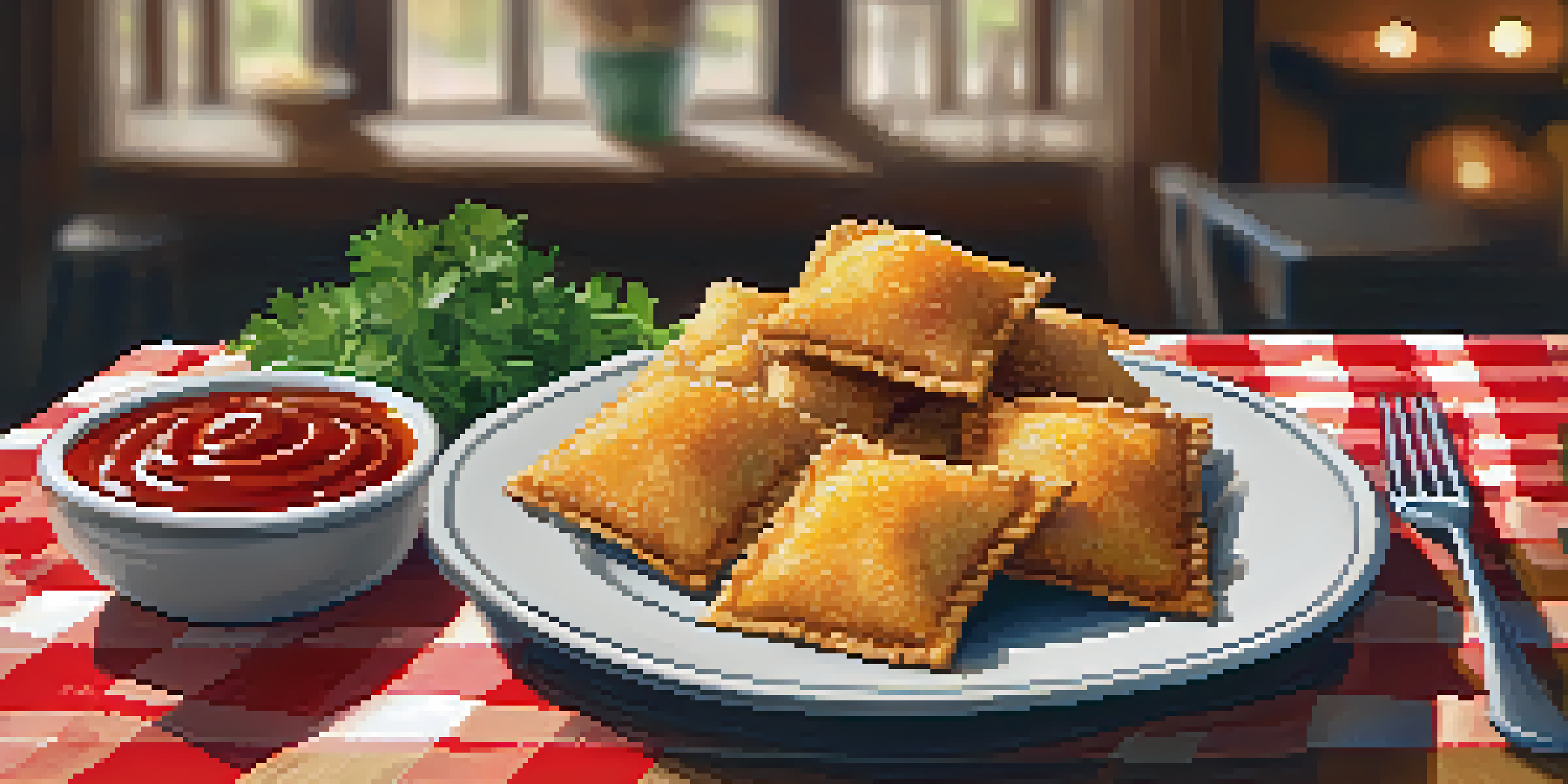The History of St. Louis Cuisine: A Culinary Journey

The Early Days: Native Ingredients and Settler Influence
St. Louis cuisine has deep roots that trace back to its Native American inhabitants. These early communities relied on local ingredients, such as wild game, fish, and seasonal vegetables, which formed the foundation of regional dishes. When European settlers arrived, they brought their culinary traditions, blending them with indigenous flavors to create a unique fusion.
Food is a cultural artifact, a reflection of our history and our identities.
The convergence of these cultures established a diverse food landscape, where dishes like venison stew and corn cakes became staples. This melding of flavors set the stage for St. Louis's culinary identity, reflecting both the land's bounty and the people’s heritage. It was a time when food was not just sustenance but a way to share stories and traditions.
As St. Louis grew, so did its culinary repertoire, influenced by various immigrant populations. Each new wave of settlers contributed their own dishes, enriching the local palette. This early era laid the groundwork for a vibrant food culture that would continue to evolve over the years.
The Rise of Iconic Dishes: Toasted Ravioli and Gooey Butter Cake
As the city developed, certain dishes began to define St. Louis cuisine, with toasted ravioli standing out as a local favorite. This delightful appetizer, which features breaded and fried ravioli, originated in the Italian neighborhoods of St. Louis in the 1940s. It quickly became a beloved snack, often served with marinara sauce for dipping.

Another sweet treat that emerged from the city is the gooey butter cake, a dessert that epitomizes indulgence. Created by accident in the 1930s, this cake combines butter, sugar, and cream cheese to create a rich, gooey center that has captivated locals and visitors alike. Both dishes showcase the city’s penchant for comfort food and reflect its unique culinary heritage.
Diverse Roots of St. Louis Cuisine
St. Louis cuisine combines Native American ingredients and European settler influence, creating a rich culinary heritage.
These iconic dishes not only satisfy cravings but also tell the story of St. Louis’s evolution. They symbolize the city's ability to embrace creativity while honoring its roots, making them essential parts of the local food culture. Today, you can find these dishes in restaurants and homes, keeping the traditions alive.
Barbecue: A St. Louis Tradition with a Unique Twist
No discussion of St. Louis cuisine would be complete without mentioning its BBQ scene. Known for its distinctive style, St. Louis barbecue features pork ribs that are cut in a unique manner, often referred to as 'St. Louis-style ribs.' This method results in a meatier, more flavorful cut that has become a local favorite.
Cooking is like love. It should be entered into with abandon or not at all.
What sets St. Louis barbecue apart is not just the cut of meat, but also the sauce. A sweet and tangy tomato-based sauce, often with a hint of molasses, is slathered on the ribs before and after cooking, creating a mouthwatering glaze. This combination of flavors has garnered a loyal following, making barbecue a cornerstone of local dining.
The city's barbecue culture has also fostered a sense of community, with annual festivals celebrating this beloved cuisine. From backyard cookouts to professional competitions, St. Louisans take great pride in their barbecue heritage, illustrating how food can bring people together. It's a delicious reminder of the city’s rich culinary landscape.
The Influence of German and Czech Immigrants on Local Cuisine
The influx of German and Czech immigrants in the 19th century left a significant mark on St. Louis cuisine. These communities introduced a variety of flavors and cooking techniques, enriching the local food scene. Dishes like bratwurst and schnitzel became popular, showcasing the melding of cultures within the city.
Beer gardens also became a staple, providing a social hub for residents to enjoy hearty meals accompanied by local brews. The tradition of brewing beer has continued, with numerous craft breweries now dotting the landscape, each contributing to the city’s vibrant food and drink culture. This integration of German and Czech influences highlights the importance of community in shaping culinary traditions.
Iconic Dishes Define Local Culture
Signature dishes like toasted ravioli and gooey butter cake showcase St. Louis's unique comfort food identity.
Today, you can still find authentic German and Czech restaurants throughout St. Louis, where traditional recipes are celebrated. The impact of these immigrant groups is a testament to the city’s diversity and how it has shaped the culinary journey over the years. Their legacy lives on, reminding us of the rich tapestry of flavors that define St. Louis cuisine.
Modern Influences: Culinary Innovation and Fusion
In recent years, St. Louis has embraced a wave of culinary innovation, with chefs experimenting and fusing different cuisines. The city's dining scene has transformed into a playground for food enthusiasts, where traditional dishes are reimagined with global influences. This trend reflects a broader movement in the culinary world, emphasizing creativity and diversity.
Food trucks and pop-up restaurants have played a vital role in this evolution, offering unique flavors and experiences. From Asian fusion tacos to gourmet doughnuts, these mobile eateries showcase the city's willingness to embrace new ideas while honoring its culinary roots. This dynamic atmosphere keeps the culinary landscape fresh and exciting.
Moreover, the rise of farm-to-table dining has encouraged chefs to collaborate with local farmers, creating seasonally inspired menus. This focus on fresh, local ingredients not only enhances the flavors but also supports the community. It’s an exciting time for St. Louis cuisine as it continues to evolve while staying true to its rich history.
The Role of Festivals in Celebrating St. Louis Cuisine
Festivals play a crucial role in celebrating the diverse culinary landscape of St. Louis. Events like the St. Louis Art Fair and the Great Forest Park Balloon Race feature local food vendors, showcasing the city's vibrant food culture. These gatherings allow residents and visitors to experience a wide array of flavors, from traditional dishes to modern creations.
Food festivals also foster a sense of community, bringing people together to share in the joy of good food. They create an opportunity for local chefs and restaurants to gain exposure, allowing them to connect with potential customers. These events often highlight the stories behind the dishes, deepening the appreciation for local cuisine.
Future Trends in Culinary Innovation
The future of St. Louis cuisine embraces plant-based trends and inclusivity, promising a vibrant and diverse dining scene.
Through these celebrations, St. Louis cuisine is not only preserved but also continually redefined. It’s an invitation to explore the rich flavors and traditions that make the city unique. Each festival serves as a reminder of the importance of food in cultural identity and community connection, ensuring that St. Louis's culinary journey continues to thrive.
The Future of St. Louis Cuisine: Trends and Predictions
As we look to the future, St. Louis cuisine is poised for exciting developments. Trends such as plant-based eating and sustainable practices are becoming increasingly popular among local chefs and diners alike. This shift not only reflects a growing awareness of health and environmental issues but also opens up new avenues for culinary creativity.
With an emphasis on inclusivity, there’s a strong push to highlight the culinary contributions of underrepresented communities. This movement encourages a broader exploration of global flavors and techniques, enriching the local dining scene. As St. Louis continues to evolve, it will likely embrace a more diverse range of culinary influences.

Ultimately, the future of St. Louis cuisine lies in its ability to adapt while honoring its rich history. By blending tradition with innovation, the city will continue to be a culinary destination, offering a unique experience for food lovers. It’s an exciting time, and the journey of St. Louis cuisine is far from over.